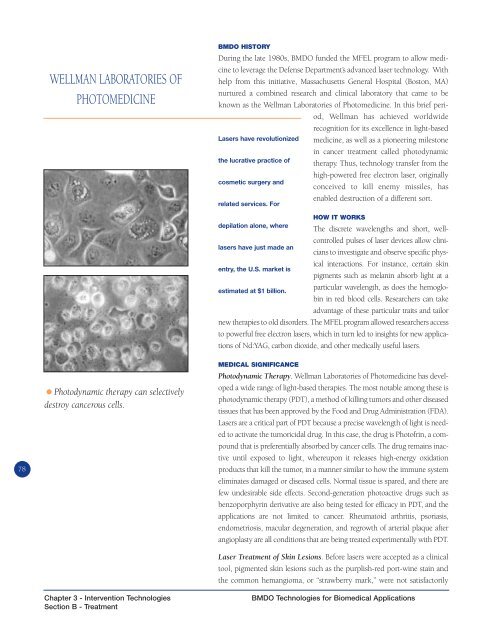bmdo technologies for biomedical applications - MDA Technology
bmdo technologies for biomedical applications - MDA Technology
bmdo technologies for biomedical applications - MDA Technology
Create successful ePaper yourself
Turn your PDF publications into a flip-book with our unique Google optimized e-Paper software.
WELLMAN LABORATORIES OFPHOTOMEDICINEBMDO HISTORYDuring the late 1980s, BMDO funded the MFEL program to allow medicineto leverage the Defense Department’s advanced laser technology. Withhelp from this initiative, Massachusetts General Hospital (Boston, MA)nurtured a combined research and clinical laboratory that came to beknown as the Wellman Laboratories of Photomedicine. In this brief period,Wellman has achieved worldwiderecognition <strong>for</strong> its excellence in light-basedLasers have revolutionized medicine, as well as a pioneering milestonein cancer treatment called photodynamicthe lucrative practice of therapy. Thus, technology transfer from thehigh-powered free electron laser, originallycosmetic surgery andconceived to kill enemy missiles, hasenabled destruction of a different sort.related services. ForHOW IT WORKSdepilation alone, whereThe discrete wavelengths and short, wellcontrolledpulses of laser devices allow cliniciansto investigate and observe specific phys-lasers have just made anical interactions. For instance, certain skinentry, the U.S. market ispigments such as melanin absorb light at aparticular wavelength, as does the hemoglobinin red blood cells. Researchers can takeestimated at $1 billion.advantage of these particular traits and tailornew therapies to old disorders. The MFEL program allowed researchers accessto powerful free electron lasers, which in turn led to insights <strong>for</strong> new <strong>applications</strong>of Nd:YAG, carbon dioxide, and other medically useful lasers.78• Photodynamic therapy can selectivelydestroy cancerous cells.Chapter 3 - Intervention TechnologiesSection B - TreatmentMEDICAL SIGNIFICANCEPhotodynamic Therapy. Wellman Laboratories of Photomedicine has developeda wide range of light-based therapies. The most notable among these isphotodynamic therapy (PDT), a method of killing tumors and other diseasedtissues that has been approved by the Food and Drug Administration (FDA).Lasers are a critical part of PDT because a precise wavelength of light is neededto activate the tumoricidal drug. In this case, the drug is Photofrin, a compoundthat is preferentially absorbed by cancer cells. The drug remains inactiveuntil exposed to light, whereupon it releases high-energy oxidationproducts that kill the tumor, in a manner similar to how the immune systemeliminates damaged or diseased cells. Normal tissue is spared, and there arefew undesirable side effects. Second-generation photoactive drugs such asbenzoporphyrin derivative are also being tested <strong>for</strong> efficacy in PDT, and the<strong>applications</strong> are not limited to cancer. Rheumatoid arthritis, psoriasis,endometriosis, macular degeneration, and regrowth of arterial plaque afterangioplasty are all conditions that are being treated experimentally with PDT.Laser Treatment of Skin Lesions. Be<strong>for</strong>e lasers were accepted as a clinicaltool, pigmented skin lesions such as the purplish-red port-wine stain andthe common hemangioma, or “strawberry mark,” were not satisfactorilyBMDO Technologies <strong>for</strong> Biomedical Applications




